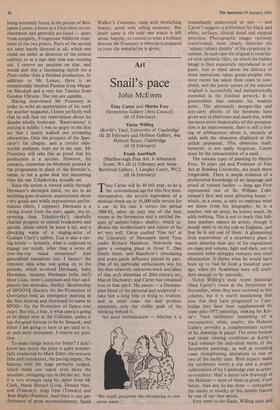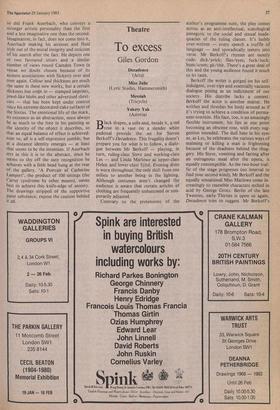Art
Snail's pace
John McEwen
Tony Carter and Martin Froy (Serpentine Gallery [Arts Council] till 13 February)
Victor Willing (Kettle's Yard, University of Cambridge till 20 February and Hobson Gallery, 44a Hobson Street, Cambridge till 19 February) Frank Auerbach (Marlborough Fine Art, 6 Albemarle Street, WI till 11 February and Anne Berthoud Gallery, 1 Langley Court, WC2 till 16 February)
Tony Carter will be 40 this year, so he is the conventional age for this first mini- retrospective, the artistic equivalent of a medical check-up or 10,000-mile service for a car. In his case it covers the period 1968-82, takes up only one of the four rooms at the Serpentine and is entitled im- ages of subject/object duality, which in- dicates the intellectuality and nature of his art very well. Carter studied 'Fine Art' at the University of Newcastle upon Tyne under Richard Hamilton. Newcastle was quite a swinging place in those T. Dan Smith times, and Hamilton's stimulating and avant-garde influence played its part. One of his particular enthusiasms was for the then relatively unknown work and ideas of that arch ideasman of 20th-century art, Marcel Duchamp; and Carter has remained true to that spirit. His pieces — a Ducham- pian blend of the pictorial and sculptural take him a long time to bring to fruition, and in most cases the end product represents only the visible peak of the thinking behind it.
Art must communicate — whether it is `We might postpone the christening to con- serve water.' immediately understood or not — and Carter's suggests a preference for black and white, surfaces, clinical detail and surgical precision. Photographic images variously transformed, most clearly illustrate the 'subject/object duality' of his corporate in- tention. In each case the original is resurfac- ed with synthetic filler, on which the hidden image is then exquisitely reproduced in oil paint. Just to think about the delicacy of these operations raises goose-pimples (the most recent has taken three years to com- plete), and the poetic nature of the selected original is successfully and metaphorically extended in the finished artwork. It is presentation that remains his weakest point. The alternately morgue-like and arty-tarty plinths of the Seventies have given way to platforms and easels but, while the more overt theatricality of this presenta- tion is an improvement, there is still a feel- ing of arbitrariness about it, uneasily at odds with the obsession displayed in the article presented. This obsession itself, however, is not easily forgotten. Carter must be the reincarnation of a snail.
The various types of painting by Martin Froy, 56 years old and Professor of Fine Art at Reading University, are much more forgettable. There is ample evidence of a professorial knowledge of art language and proof of trained facility — long ago Froy represented one of Sir William Cold- stream's first and most glittering hopes which, in a sense, is only to rephrase what we know from his biography: he is a teacher, not an artist; he knows much, he adds nothing. This Is not to imply that run- time teachers cannot be artists, though it would seem to be the rule in England, just that he is not one of them. A glimmering little watercolour of a strawberry plant is more pleasing than any of his expositions on mass and volume, light and dark, not to mention some unhappy ventures into total abstraction. It shows what he would have been up to had he lived a hundred years ago, when the Academies were still confi- dent enough to be untrendy.
Victor Willing's most recent paintings filled Carter's room at the Serpentine in November, when they were reviewed in this column, but it is worth mentioning that now that they have progressed to Cam- bridge they have been supplemented by some post-1975 paintings, making his Ket- tle's Yard exhibition something of a retrospective; while, nearby, the Hobson Gallery provides a complementary survey of his drawings in pastel. The more broken and closer viewing conditions at. Kettle's Yard enhance the individual merits of the Serpentine paintings, as well as revealing some strengthening alterations to one or two of the earlier ones. Both aspects make the exhibition worth a trip and a proper culmination of his Cambridge year as artist- in-residence. Half a dozen new drawings at the Hobson — most of them as good, if not better, than any he has done — strengthen the claims to novelty of this double feature by one of our best artists. Froy went to the Slade, Willing went and so did Frank Auerbach, who conveys a stronger artistic personality than the first and a less imaginative one than the second. Imagination, in fact, does not come into it, Auerbach making his anxious and fluid kyle out of the moral integrity and stoicism of his search after the fact. He depicts one or two favoured sitters and a similar number of views round Camden Town (a venue no doubt chosen because of its austere associations with Sickert) over and over again. Colour and thickness are much the same in these new works, but a certain slickness has crept in — stamped imprints, jewel-like blobs and other advertised short- cuts — that has been kept under control since his extreme decorated-cake surfaces of the Sixties. The emotional life of the mark, its existence as an abstraction, must always be as much to the fore in his painting as the identity of the object it describes, so that an equal balance of effect is achieved: near to, all is a self-expressive jumble, but at a distance identity emerges — at least that seems to be the intention. If Auerbach errs in this it is to the abstract, since he seems to shy off the easy recognition he achieves with a little head hung at the rear of the gallery. 'A Portrait of Catherine Lampert', the product of 100 sittings (the Carter syndrome by other means), seems best to achieve this knife-edge of anxiety. The drawings stripped of the supportive paint substance, expose the caution behind it all.







































 Previous page
Previous page